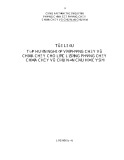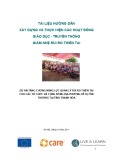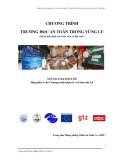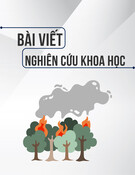
144
HNUE JOURNAL OF SCIENCE
Natural Sciences 2024, Volume 69, Issue 1, pp. 144-160
This paper is available online at http://stdb.hnue.edu.vn
DOI: 10.18173/2354-1059.2024-0014
LANDSLIDE SUSCEPTIBILITY ASSESSMENT
IN QUANG NAM PROVINCE USING STATISTICAL INDEX
AND ANALYTICAL HIERARCHICAL PROCESS
Nguyen Thi Thu Hien*, Dang Thi Hue
Faculty of Geography, Ha Noi National University of Education, Hanoi city, Vietnam
*Corresponding author: Nguyen Thi Thu Hien, e-mail: hienntt@hnue.edu.vn
Received January 17, 2024. Revised March 20, 2024. Accepted March 27, 2024.
Abstract. More than 70% of the areas of Quang Nam province are mountainous
terrain with heavy and seasonal rainfall. In recent years, economic activities and the
work of humans have increased dramatically, destroying vegetation cover, and
causing the natural environment to change significantly, which promotes the
occurrences, development, and increase of landslides. This research uses the
statistical index to determine the weight of each class in each factor and an analytical
hierarchical process (AHP) to determine the weight of factors. A landslide
susceptibility assessment map was established by integrating the factor maps. The
result showed that landslide susceptibility in Quang Nam was categorized as 28.53%
for low and very low; 39.66% for moderate, and 31.82% for high and very high.
Keywords: landslide, statistical index, analytical hierarchical process (AHP),
Quang Nam province.
1. Introduction
Landslides are considered one of the common natural hazards in many parts of the
world [1]. Globally, landslides cause billions of dollars worth of damage and thousands
of deaths and injuries each year. In Vietnam, landslides often occur during the rainy
season in the mountainous areas of the Northwest, Northeast, and Central regions, causing
great damage to people, facilities, and the environment. In 2020, the country had 59
landslides and flash floods, causing 132 deaths or disappearances and about 527 billion
VND worth of damage [2].
A landslide is the movement of soil and rock down the slope under the influence of
gravity [3]. Landslides occur when the rock mass is unbalanced and the shear stress
exceeds resistance. This situation often occurs when the material on the slope is saturated
with water, the foot of the slope is lost, or underground erosion reduces the binding force
between the permeable layer and the surface of the retaining layer. This often occurs in

Landslide susceptibility assessment in Quang Nam province using statistical index…
145
areas with significant moisture, lithology rich in clay material, and other favorable
structural conditions.
Landslides have attracted the attention of many research scientists by introducing
concepts, definitions, and classifications and identifying the causes of landslides [1], [4]-[7].
Assessing and zoning landslide risk is also the goal that research aims to achieve. In recent
years, there have been many different landslide risk assessment methods, of which the
group of statistical methods is the most widely used. Statistical methods are based on the
analysis of the functional relationships between instability factors and existing landslides.
Various statistical methods have been applied for slope instability such as bivariate
approaches and multivariate approaches. The bivariate approaches for the study include
five different methods: statistical index, certainty factor, landslide susceptibility analysis,
probability method, and weight of evidence modeling. Multivariate approaches for
landslide susceptibility mapping in the study include two methods: multiple linear
regression and logistic regression analysis. Of the two groups of methods, bivariate
approaches are relatively easy to use with the simpler analysis algorithm so they should
be used in many research projects [8], [9].
In Vietnam, landslide studies also aim at zoning and predicting landslide risk. Studies
have established zoning maps to predict landslide risk at different levels such as national
scale [10], regional level [11], inter-provincial, provincial level [12], district level [ 13],
and a route [14]. These studies have applied many modern methods such as analytic
hierarchy process (AHP) methods [12], [14], [15], statistical index [12], the weight of
evidence [13], [15], and certainty factor modeling [15].
Quang Nam, located in the center of the central region with diverse terrain including
lowlands, midlands, mountainous areas, and a humid tropical climate, Quang Nam has
many favorable conditions for socio-economic development. However, apart from these
advantages, over 70% of the terrain is a mountainous area with steep slopes and deep
divergence of dry-rainy climate that can cause natural hazards, including landslides. On
the other hand, in recent decades, to meet the requirements of the reform process, the
system of local infrastructure has been developed dramatically. Many roads have been
maintained, repaired, and upgraded; hydropower projects have been built and operated;
mineral mines have been expanded and exploited...Economic activities and the work of
humans cause the natural environment to substantially change, quickly raising the
development of slopes and causing increased landslides.
Reality shows that the landslide in Quang Nam takes place every year, causing great
losses of people and property. Landslides can cause thousands of cubic meters of soil and
stone to fall down and destroy homes, and work, threatening life or burying residents and
damaging many roads. Therefore, assessing and identifying areas at risk of landslides in
Quang Nam province to have solutions to prevent and minimize damage are very
necessary and have scientific and practical significance.
Studies on landslides in Quang Nam in recent years have done quite a lot in different
scales and aspects such as analysis and investigation of landslides [16], evaluation and
forecast of the landslide risk in some areas, along the transport routes or in the entire
province [12], [14]. However, the assessment of landslide risk in some studies is

Nguyen TTH* & Dang TH
146
incomplete and not integrated. Determining the role of factors by assigning weights is
subjective. In this study, landslide susceptibility in Quang Nam is evaluated according to
an integrated perspective and systems approach. A combination of statistical index
models and analytical hierarchy process (AHP) aims to increase objectivity in
determining the weights for factors and the weights of each class in each factor, promoting
reliability, accuracy, and quantification of assessment results. Furthermore, unlike most
previous studies that mainly used the average annual rainfall index, in this study, the
autumn precipitation indicator (cumulative rainfall in the 3 months of September,
October, and November – rainfall in the rainy season) was selected for landslide analysis
because in Quang Nam, the rainy season concentrates more than 60% of the annual total
precipitation and most landslides occur during this period.
2. Content
2.1. Landslide susceptibility evaluating method
Landslide hazard assessment in Quang Nam province is based on the landslide
susceptibility map; the integration of the various factors and classes in a single landslide
susceptibility index (LSI) is accomplished by a procedure based on the weighted linear
sum as follows:
1
n
j ij
j
LSI W w
=
=
where,
LSI: Landslide susceptibility index;
Wj: weight value of parameter j;
wij: rating value or weight value of class i in parameter j;
n: number of parameters.
Based on the analysis of landslide inventory, nine relevant factors are selected as
inputs for the models of landslide susceptibility mapping in this study, i.e. lithological
composition, fault density, weathering crust, slope, deep dividing density, autumn
rainfall, drainage density, land and distance from roads.
- Method of defining the weight value for a parameter class - statistical index method.
The statistical index method is a bivariate statistical analysis introduced by Van
Westen for landslide susceptibility analyses. In this method, a weight value for a
parameter class, such as a certain fault density unit or a certain slope class, is defined as
the natural logarithm of the landslide density in the class divided by the landslide density
in the entire map. This method is based on the following formula [8]:
**
ln ln ln
**
f A A
AA
ij ij ij
wij f A A
AA
ij ij
= = =
where,

Landslide susceptibility assessment in Quang Nam province using statistical index…
147
wij: The weight is given to a certain class i of parameter j.
fij: The landslide density within class i of parameter j.
f: The landslide density within the entire map.
A*ij: Area of landslides in a certain class i of parameter j.
Aij: Area of a certain class i of parameter j.
A*: Total area of landslides in the entire map.
A: Total area of the entire map
Hence, the statistical index method is based on the statistical correlation of the
landslide inventory map with attributes of different parameter maps. The wij value in this
equation is only calculated for classes that have landslide occurrences. In the case of no
landslide occurrences in a parameter class, the wij will be assigned to zero [8].
- Method of defining the weight value of the parameter - Analytical hierarchy process
(AHP) method.
In reality, the influence of each factor differs; it is essential to quantify the relative
weight of each contributing factor in a landslide. Factor weights are determined by a pair-
wise comparison matrix using AHP. In the construction of a pair-wise comparison matrix,
each factor is rated against every other factor by assigning a relative importance value
between 1 and 9 to the intersecting cell. When the factor on the vertical axis is more
important than the factor on the horizontal axis, this value varies between 1 and 9.
Conversely, the value varies between 1/2 and 1/9 (Table 1) [17], [18].
Table 1. Scale of preference between two parameters in AHP [18]
Scale
Degree of
preference
Explanation
1
Equally
important
Two activities contribute equally to the objective
3
Moderately
more important
Experience and judgment slightly to moderately favor
one activity over another
5
Strongly more
important
Experience and judgment strongly or essentially favor
one activity over another
7
Very Strongly
more important
An activity is strongly favored over another and its
dominance is shown in practice
9
Extremely
important
The evidence of favoring one activity over another is
of the highest degree possible of an affirmation
2, 4, 6, 8
Intermediate
Used to represent compromises between the
preferences in weights 1, 3, 5, 7, and 9
Reciprocals
Opposites
Used for inverse comparison
Pair-wise comparison, however, is subjective and the results are highly dependent on
the expert's judgment. Usually, the relevant importance between two factors is specified
by sending questionnaires to different experts, who are asked to compare the relative
importance between two factors with respect to the goal.
The analytical hierarchy process (AHP) method is its ability to evaluate quantitative
and qualitative criteria so it is a semi-quantitative method.

Nguyen TTH* & Dang TH
148
2.2. Results and discussion
2.2.1. Landslide inventory mapping
Landslides are very common in this region, especially during the rainy season when
rainfall is highly concentrated as typhoons are frequent in September, or when rainfall
lasts for long periods (e.g., days or weeks) in October and November. In this study, the
author conducted field surveys of landslide occurrences in several areas in the study area
in October 2009. The field survey results have identified 157 sliding blocks, including 40
large sliding blocks, 50 medium sliding blocks, and 67 small sliding blocks. The author
refers to the landslide inventory from the research by Dr. Pham Van Hung and his
colleagues in 2010 with 528 landslides, including 264 large landslides, 90 moderate
landslides, and 174 small landslides. The landslide inventory map for Quang Nam
province was established after eliminating overlapping landslide points. The results show
that there are 583 landslides of different sizes covering 10438.37 km2 (Figure.1). The
average density is about 5 cubic landslides,100 km2 of which are 265 large landslides,
accounting for 45.5%, 113 moderate landslides, accounting for 19.4% and 205 small
landslides, accounting for 35.1%.
Landslides are distributed almost throughout the hilly area of the province,
concentrating on greater density in medium mountain areas - low mountains of Dong
Giang, Phuoc Son, Nam Giang, and Nam Tra My district. The landslide was also
concentrated on a few low hills areas of Dai Loc, Duy Xuyen, Tien Phuoc, and North Tra
My district.
Landslides occurred seriously in the area of ferosialite, sialferite weathering of
metamorphic rock in Kham Duc formation, Tac Po formation, Upper - Lower A Vuong
formation, and the intrusive magmatic rocks of Dai Loc complex, Ben Giang - Que Son
complex, Chu Lai complex.
Figure 1. Landslide inventory map in Quang Nam province







![Tài liệu công tác phòng cháy chữa cháy cho ban quản trị tòa nhà [mới nhất]](https://cdn.tailieu.vn/images/document/thumbnail/2023/20230314/havyvy205/135x160/9011678784594.jpg)






![Quy hoạch tổng thể Cà Mau: Tài liệu [mới nhất/chuẩn nhất]](https://cdn.tailieu.vn/images/document/thumbnail/2025/20250827/tghong1621@gmail.com/135x160/49401756278390.jpg)


![Bài giảng Hàng hải địa văn [chuẩn nhất]](https://cdn.tailieu.vn/images/document/thumbnail/2025/20250729/vijiraiya/135x160/43361753782101.jpg)
![Bài giảng Trắc địa cơ sở [mới nhất]](https://cdn.tailieu.vn/images/document/thumbnail/2025/20250729/vijiraiya/135x160/84_bai-giang-trac-dia-co-so.jpg)





![Atlas tài nguyên nước Việt Nam: Tài liệu [Mô tả/Hướng dẫn/Chi tiết]](https://cdn.tailieu.vn/images/document/thumbnail/2025/20250715/vijiraiya/135x160/348_tai-lieu-atlas-tai-nguyen-nuoc-viet-nam.jpg)
![Hệ thống câu hỏi ôn tập Vùng kinh tế [chuẩn nhất]](https://cdn.tailieu.vn/images/document/thumbnail/2025/20250709/kimphuong1001/135x160/76921752140578.jpg)
